Places where I have been in Jamaica: 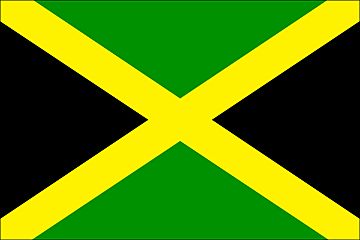
Ocho Rios
Dunns River Falls, Jamaica
Places related:
Bahamas
Nassau
Jamaica is an island nation of the Greater Antilles, 234 kilometres (145 mi) in length and as much as 80 kilometres (50 mi) in width, amounting to 11,100 km2. It is situated in the Caribbean Sea, about 145 kilometres (90 mi)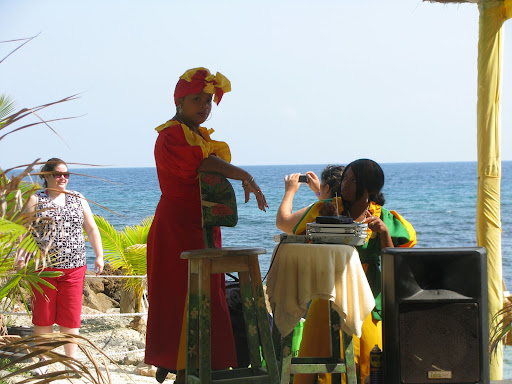 south of Cuba, and 190 kilometres (120 mi) west of Hispaniola, the island harboring the nation-states Haiti and the Dominican Republic. Its indigenous Arawakan-speaking Taíno inhabitants named the island Xaymaca, meaning the "Land of Wood and Water", or the "Land of Springs".
south of Cuba, and 190 kilometres (120 mi) west of Hispaniola, the island harboring the nation-states Haiti and the Dominican Republic. Its indigenous Arawakan-speaking Taíno inhabitants named the island Xaymaca, meaning the "Land of Wood and Water", or the "Land of Springs".
Formerly a Spanish possession known as Santiago, it later became the British Crown colony of Jamaica. With 2.8 million people, it is the third most populous anglophone country in the Americas, after the United States and Canada. It remains a Commonwealth realm with Queen Elizabeth II as Head of State. Kingston is the largest city in Jamaica and the country's capital.
The Arawak and Taino indigenous people originating from South America settled on the island between 4000 and 1000 BC. When Christopher Columbus arrived in 1494 there were over 200 villages ruled by caciques (chiefs of villages). The south coast of Jamaica was the most populated, especially around the area now known as Old Harbour. The Tainos were still inhabiting Jamaica when the English took control of the island. The Jamaican National Heritage Trust is attempting to locate and document any evidence of the Taino/Arawaks.
National Heritage Trust is attempting to locate and document any evidence of the Taino/Arawaks.
Christopher Columbus claimed Jamaica for Spain after landing there in 1494. Columbus' probable landing point was Dry Harbour, now called Discovery Bay. St. Ann's Bay was the "Saint Gloria" of Columbus who first sighted Jamaica at this point. One mile west of St. Ann's Bay is the site of the first Spanish settlement on the island, Sevilla, which was abandoned in 1554 because of numerous pirate raids.
The capital was moved to Spanish Town, now located in the parish of St. Catherine, as early as 1534. It was then called "Villa de la Vega". Spanish Town has the oldest Cathedral in the British colonies. The Spanish were forcibly evicted by the English at Ocho Rios in St. Ann. However, it was not until 1655 that, at Tower Isle, the English took over the last Spanish fort in Jamaica. The Spaniard Don Cortez Arnoldo de Yassi kept Tower Hill (the site of Tower Isle) from the English for five years, before escaping to Cuba. The site of his departure was fittingly called "Runaway Bay", which is also in St. Ann. The name of Montego Bay, the capital of the parish of St. James, was derived from the Spanish name manteca bahía (or Bay of Lard) for the large quantity of boar used for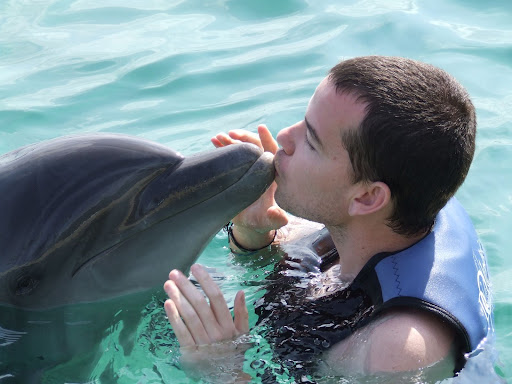 the lard-making industry.
the lard-making industry.
The English Admiral William Penn (father of William Penn of Pennsylvania) and General Robert Venables seized the island in 1655. In 1660 the population of Jamaica was about 4,500 whites and some 1,500 blacks. As early as the 1670s, blacks formed a majority of the population.
When the English captured Jamaica in 1655 the Spanish colonists fled leaving a large number of African slaves. Rather than be re-enslaved by the English, they escaped into the hilly, mountainous regions of the island, joining those who had previously escaped from the Spanish to live with the Taínos. These runaway slaves, who became known as the Jamaican Maroons, fought the British during the 18th century. The name is still used today for their modern descendants. During the long years of slavery Maroons established free communities in the mountainous interior of Jamaica, maintaining their freedom and independence for generations.
During its first 200 years of British rule, Jamaica became one of the world's leading sugar-exporting, slave-dependent nations, producing more than 77,000 tons of sugar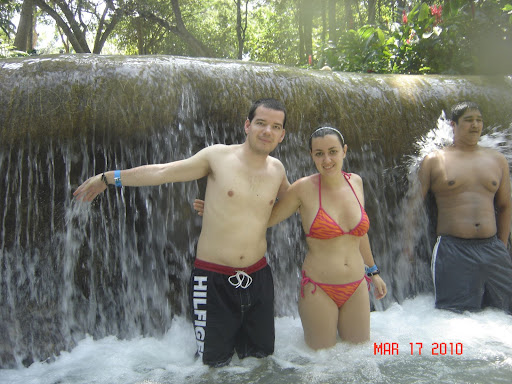 annually between 1820 and 1824. After the abolition of the slave trade (but not slavery itself) in 1807, the British imported Indian and Chinese workers as indentured servants to supplement the labour pool. Descendants of indentured servants of Asian and Chinese origin continue to reside in Jamaica today.
annually between 1820 and 1824. After the abolition of the slave trade (but not slavery itself) in 1807, the British imported Indian and Chinese workers as indentured servants to supplement the labour pool. Descendants of indentured servants of Asian and Chinese origin continue to reside in Jamaica today.
By the beginning of the 19th century, Jamaica's heavy reliance on slavery resulted in blacks (Africans) outnumbering whites (Europeans) by a ratio of almost 20 to 1. Even though England had outlawed the importation of slaves, some were still smuggled into the colonies. The British government drew-up laws regimenting the abolition of slavery, but they also included instructions for the improvement of the slaves' way of life. These instructions included a ban of the use of whips in the field, a ban on the flogging of women, notification that slaves were to be allowed religious instruction, a requirement that slaves be given an extra free day during the week when they could sell their produce as well as a ban of Sunday markets.
In Jamaica, however, these measures were resisted by the House of Assembly. The Assembly claimed that the slaves were content and objected to Parliament's interference in island affairs, although many slave owners feared possible revolts. Following a series of rebellions and changing attitudes in Great Britain, the nation formally abolished slavery in 1834, with full emancipation from chattel slavery declared in 1838. The population in 1834 was 371,070 of whom 15,000 were white, 5,000 free black, 40,000 ‘coloured’ or mixed race, and 311,070 slaves.
‘coloured’ or mixed race, and 311,070 slaves.
In the 1800s, the British established a number of botanical gardens. These included the Castleton Garden, set up in 1862 to replace the Bath Garden (created in 1779) which was subject to flooding. Bath Garden was the site for planting breadfruit brought to Jamaica from the Pacific by Captain William Bligh. Other gardens were the Cinchona Plantation founded in 1868 and the Hope Garden founded in 1874. In 1872, Kingston became the island's capital.
In 1945, Sir Horace Hector Hearne became Chief Justice and Keeper of the Records in Jamaica. He headed the Supreme Court, Kingston between 1945 and 1950/1951. He then moved to Kenya where he was appointed Chief Justice.
Jamaica slowly gained increasing independence from the United Kingdom and in 1958, it became a province in the Federation of the West Indies, a federation among the British West Indies. Jamaica attained full independence by leaving the federation in 1962.
Strong economic growth, averaging approximately 6% per annum, marked the first ten years of independence under conservative governments which w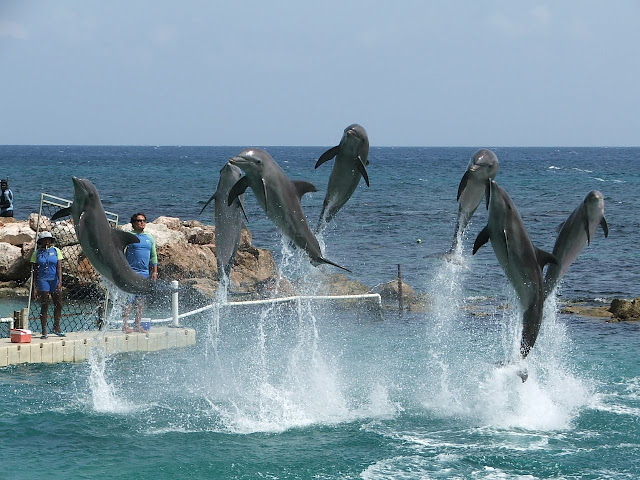 ere led successively by Prime Ministers Alexander Bustamante, Donald Sangster and Hugh Shearer. The growth was fueled by strong investments in bauxite/alumina, tourism, manufacturing industry and, to a lesser extent, the agricultural sector.
ere led successively by Prime Ministers Alexander Bustamante, Donald Sangster and Hugh Shearer. The growth was fueled by strong investments in bauxite/alumina, tourism, manufacturing industry and, to a lesser extent, the agricultural sector.
However, the optimism of the first decade was accompanied by a growing sense of inequality, and a sense that the benefits of growth were not being experienced by the urban poor. This, combined with the effects of a slowdown in the global economy in 1970, prompted the electorate to change government, electing the PNP (People's National Party) in 1972. However, despite efforts to create more socially equitable policies in education and health, Jamaica continued to lag economically, with its gross national product having fallen in 1980 to some 25% below the 1972 level. Rising foreign and local debt, accompanied by large fiscal deficits, resulted in the invitation of the International Monetary Fund (IMF) financing from the United States and others, and the imposition of IMF austerity measures (with a greater than 25% interest rate per year).
Economic deterioration continued into the mid-1980s, exacerbated by a number of factors; The first and third largest alumina producers, Alpart and Alcoa, closed and there was a significant reduction in production by the second largest producer, Alcan. In addition, tourism decreased and Reynolds Jamaica Mines, Ltd. left the Jamaican industry.
Jamaica Map:
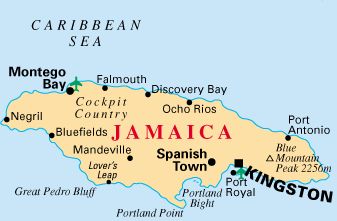
March 2010

Ocho Rios
Dunns River Falls, Jamaica
Places related:
Bahamas
Nassau
Jamaica is an island nation of the Greater Antilles, 234 kilometres (145 mi) in length and as much as 80 kilometres (50 mi) in width, amounting to 11,100 km2. It is situated in the Caribbean Sea, about 145 kilometres (90 mi)
Formerly a Spanish possession known as Santiago, it later became the British Crown colony of Jamaica. With 2.8 million people, it is the third most populous anglophone country in the Americas, after the United States and Canada. It remains a Commonwealth realm with Queen Elizabeth II as Head of State. Kingston is the largest city in Jamaica and the country's capital.
The Arawak and Taino indigenous people originating from South America settled on the island between 4000 and 1000 BC. When Christopher Columbus arrived in 1494 there were over 200 villages ruled by caciques (chiefs of villages). The south coast of Jamaica was the most populated, especially around the area now known as Old Harbour. The Tainos were still inhabiting Jamaica when the English took control of the island. The Jamaican
Christopher Columbus claimed Jamaica for Spain after landing there in 1494. Columbus' probable landing point was Dry Harbour, now called Discovery Bay. St. Ann's Bay was the "Saint Gloria" of Columbus who first sighted Jamaica at this point. One mile west of St. Ann's Bay is the site of the first Spanish settlement on the island, Sevilla, which was abandoned in 1554 because of numerous pirate raids.
The capital was moved to Spanish Town, now located in the parish of St. Catherine, as early as 1534. It was then called "Villa de la Vega". Spanish Town has the oldest Cathedral in the British colonies. The Spanish were forcibly evicted by the English at Ocho Rios in St. Ann. However, it was not until 1655 that, at Tower Isle, the English took over the last Spanish fort in Jamaica. The Spaniard Don Cortez Arnoldo de Yassi kept Tower Hill (the site of Tower Isle) from the English for five years, before escaping to Cuba. The site of his departure was fittingly called "Runaway Bay", which is also in St. Ann. The name of Montego Bay, the capital of the parish of St. James, was derived from the Spanish name manteca bahía (or Bay of Lard) for the large quantity of boar used for
The English Admiral William Penn (father of William Penn of Pennsylvania) and General Robert Venables seized the island in 1655. In 1660 the population of Jamaica was about 4,500 whites and some 1,500 blacks. As early as the 1670s, blacks formed a majority of the population.
When the English captured Jamaica in 1655 the Spanish colonists fled leaving a large number of African slaves. Rather than be re-enslaved by the English, they escaped into the hilly, mountainous regions of the island, joining those who had previously escaped from the Spanish to live with the Taínos. These runaway slaves, who became known as the Jamaican Maroons, fought the British during the 18th century. The name is still used today for their modern descendants. During the long years of slavery Maroons established free communities in the mountainous interior of Jamaica, maintaining their freedom and independence for generations.
During its first 200 years of British rule, Jamaica became one of the world's leading sugar-exporting, slave-dependent nations, producing more than 77,000 tons of sugar
By the beginning of the 19th century, Jamaica's heavy reliance on slavery resulted in blacks (Africans) outnumbering whites (Europeans) by a ratio of almost 20 to 1. Even though England had outlawed the importation of slaves, some were still smuggled into the colonies. The British government drew-up laws regimenting the abolition of slavery, but they also included instructions for the improvement of the slaves' way of life. These instructions included a ban of the use of whips in the field, a ban on the flogging of women, notification that slaves were to be allowed religious instruction, a requirement that slaves be given an extra free day during the week when they could sell their produce as well as a ban of Sunday markets.
In Jamaica, however, these measures were resisted by the House of Assembly. The Assembly claimed that the slaves were content and objected to Parliament's interference in island affairs, although many slave owners feared possible revolts. Following a series of rebellions and changing attitudes in Great Britain, the nation formally abolished slavery in 1834, with full emancipation from chattel slavery declared in 1838. The population in 1834 was 371,070 of whom 15,000 were white, 5,000 free black, 40,000
In the 1800s, the British established a number of botanical gardens. These included the Castleton Garden, set up in 1862 to replace the Bath Garden (created in 1779) which was subject to flooding. Bath Garden was the site for planting breadfruit brought to Jamaica from the Pacific by Captain William Bligh. Other gardens were the Cinchona Plantation founded in 1868 and the Hope Garden founded in 1874. In 1872, Kingston became the island's capital.
In 1945, Sir Horace Hector Hearne became Chief Justice and Keeper of the Records in Jamaica. He headed the Supreme Court, Kingston between 1945 and 1950/1951. He then moved to Kenya where he was appointed Chief Justice.
Jamaica slowly gained increasing independence from the United Kingdom and in 1958, it became a province in the Federation of the West Indies, a federation among the British West Indies. Jamaica attained full independence by leaving the federation in 1962.
Strong economic growth, averaging approximately 6% per annum, marked the first ten years of independence under conservative governments which w
However, the optimism of the first decade was accompanied by a growing sense of inequality, and a sense that the benefits of growth were not being experienced by the urban poor. This, combined with the effects of a slowdown in the global economy in 1970, prompted the electorate to change government, electing the PNP (People's National Party) in 1972. However, despite efforts to create more socially equitable policies in education and health, Jamaica continued to lag economically, with its gross national product having fallen in 1980 to some 25% below the 1972 level. Rising foreign and local debt, accompanied by large fiscal deficits, resulted in the invitation of the International Monetary Fund (IMF) financing from the United States and others, and the imposition of IMF austerity measures (with a greater than 25% interest rate per year).
Economic deterioration continued into the mid-1980s, exacerbated by a number of factors; The first and third largest alumina producers, Alpart and Alcoa, closed and there was a significant reduction in production by the second largest producer, Alcan. In addition, tourism decreased and Reynolds Jamaica Mines, Ltd. left the Jamaican industry.
Jamaica Map:

March 2010
You have read this article with the title JAMAICA, CARIBBEAN. You can bookmark this page URL http://oinsweden.blogspot.com/2010/03/jamaica-caribbean.html. Thanks!
Write by:
AN - Thursday, March 25, 2010






.jpg)



Comments "JAMAICA, CARIBBEAN"
Post a Comment